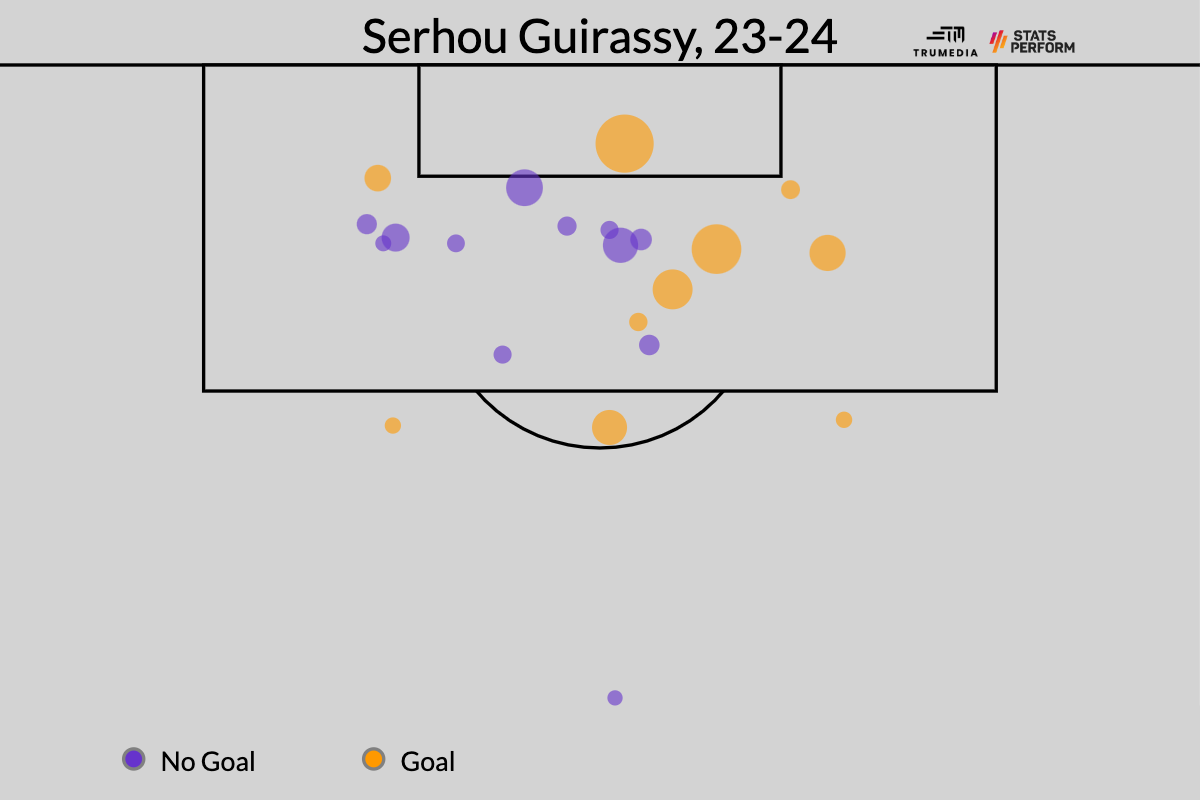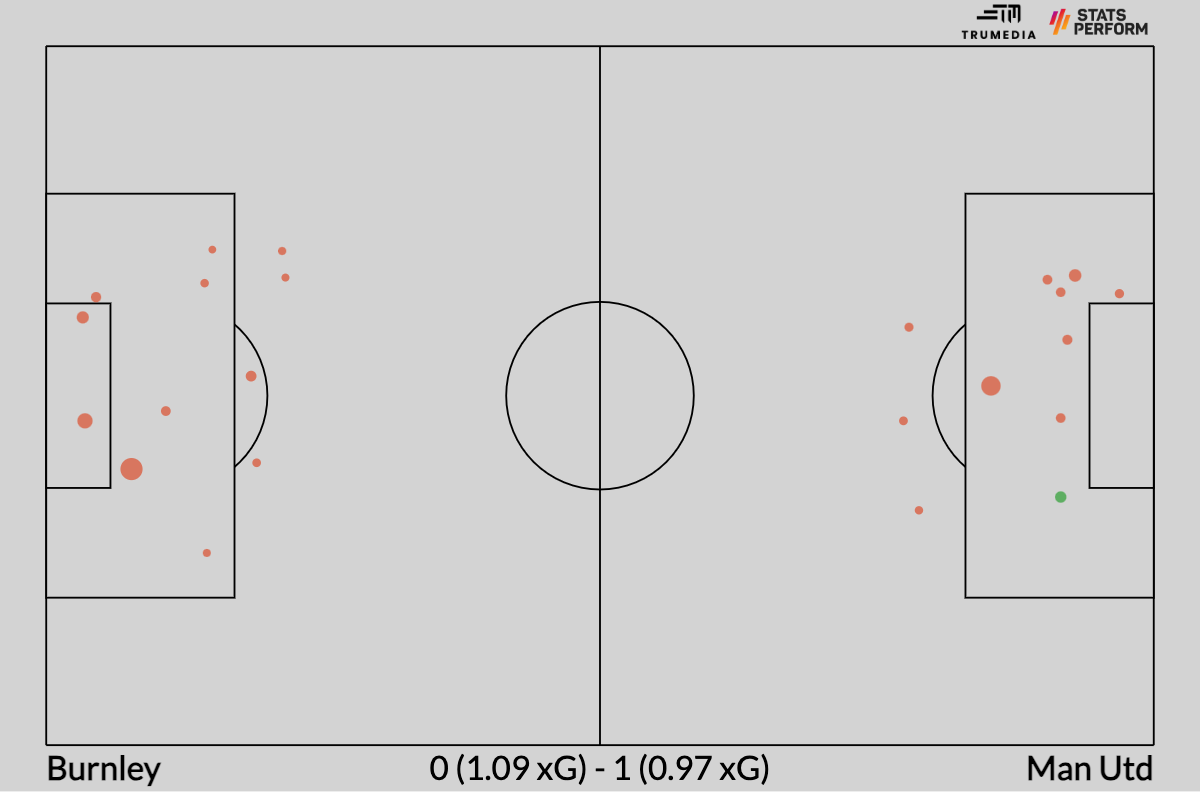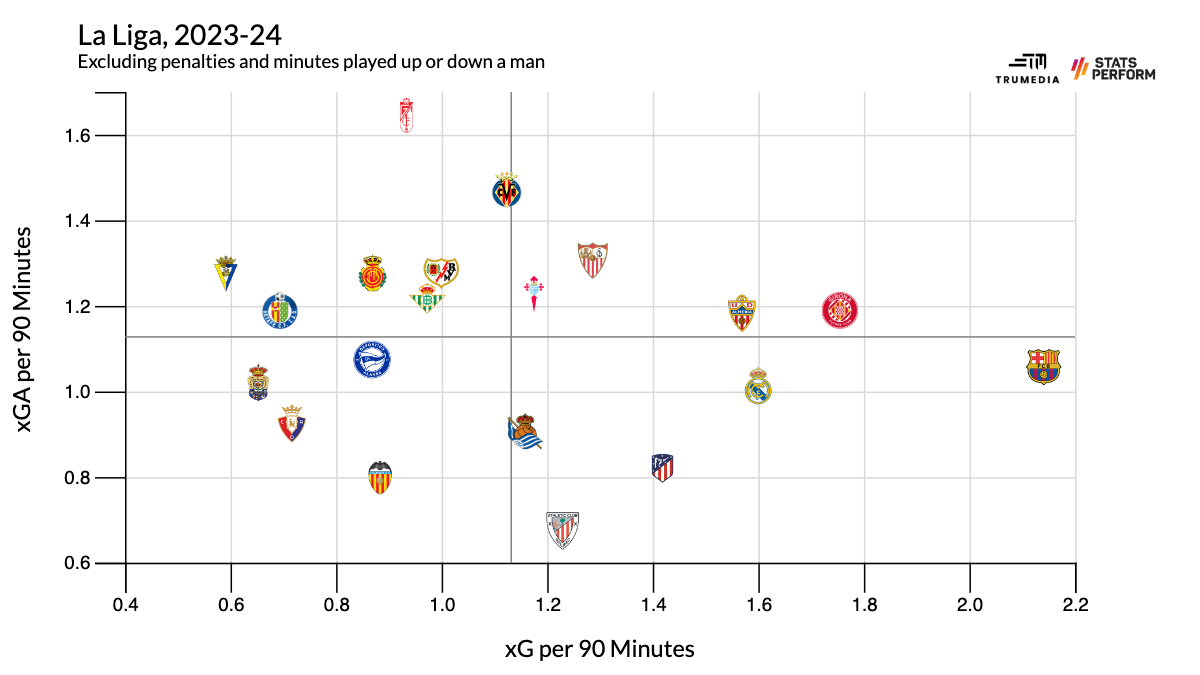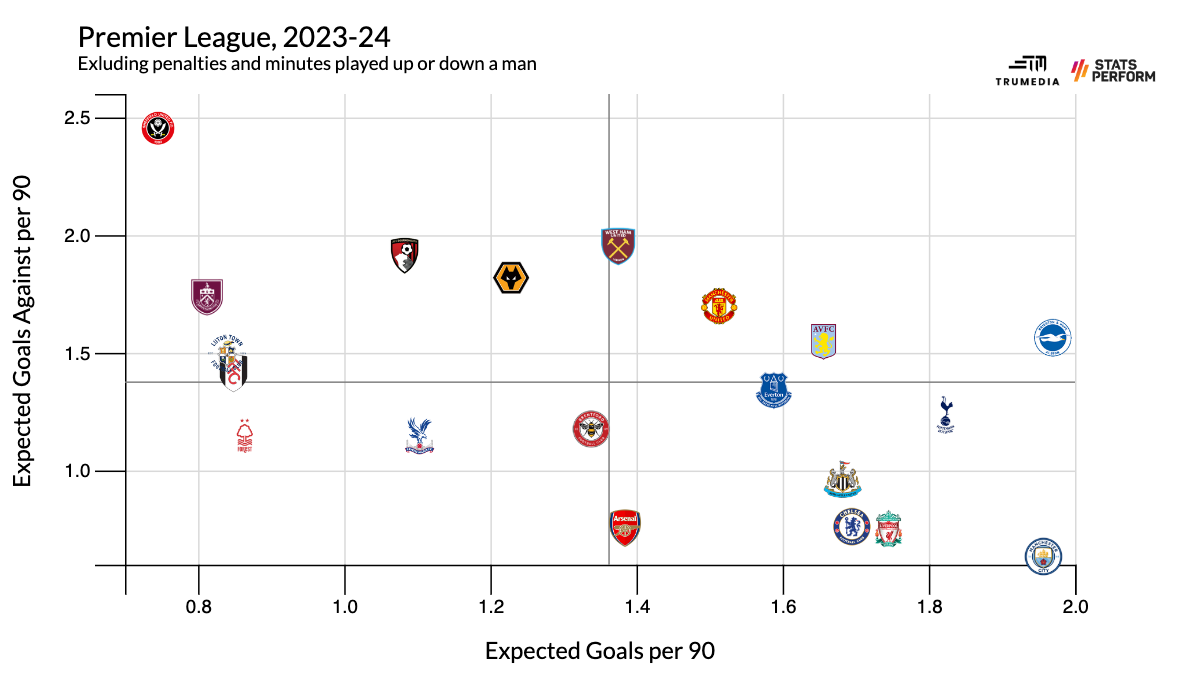A good rule of thumb among soccer analysts is that you have to wait until 10 games into a season before you really start to make any confident conclusions about what you've seen. Before then, there's just too much noise. Players are injured. Schedules are imbalanced. Red cards and penalties have an outsize effect on a team's aggregate performance, as do one or two bad or great games.
Once you get to the 10-game mark, you usually have enough matches where unexpected poor performance becomes a genuine concern and surprisingly impressive play becomes a source of genuine excitement. Random-ish events like red cards and penalties begin to even out, and everyone's schedules start to look similar.
Just take this point last season. Through six matches, Newcastle United had won only seven points from six games. It looked as though Eddie Howe's side had seemingly come back to earth after a charge up the table the previous season lifted them way beyond a relegation fight. Meanwhile, Antonio Conte & Co. had picked up where they left off from the year prior, picking up 14 points from six, sitting tied with Manchester City and just one point out of first.
Come the end of the season, the Magpies finished 11 points and four places ahead of Spurs. Howe was a Manager of the Year candidate; Conte had been unemployed for multiple months.
Of course, that doesn't mean we should write everything off, either. Two of the biggest surprises at the start of last season bookended the table: Arsenal in first with 15 points from six, and Leicester in last with just one. The Gunners didn't win the league, but they established themselves as one of the best teams in Europe, while Leicester completed a two-year slide from fifth place in the Premier League all the way down to the Championship.
So, let's take a look at some of the early surprises across Europe -- with a focus on the Premier League -- and try to figure out whether what we're seeing is real or fake.
 Tottenham are top-four contenders
Tottenham are top-four contenders
Perhaps this shouldn't be considered a surprise given that Spurs are one of the richest teams in the world. But, well, they finished eighth last season, closer to Fulham than to fourth. Oh yeah! Then they lost arguably the greatest player in club history, and possibly the best player in the league, when Harry Kane left for Bayern Munich.
Before the season began, the Sporting Index point-projection market gave Spurs an over-under of 59 points, which was tied with Aston Villa for seventh behind the rest of the Big Six and Newcastle. Six games in, they have exactly as many points as they had last season ahead of Sunday's match against Liverpool in London.
Is it a mirage, like last year? Or early signs of sustainable success?
Now, a lot has changed from last year. Yes, they have a new, lovable, aggressive and Australian manager in Ange Postecoglou, but more important than that: They have lots of new players. Kane is gone, but among their 11 most-used players this season, eight of them were not among the team's 11 most-used players last season.
Kane is a devastating loss, and I believe it's absurd to think that the team is better without him in a vacuum. However, if Spurs upgraded at the seven positions outside of center-forward, then that would more than make up for the loss of one star player.
But should we believe that to be the case?
As of now, Sporting Index projects Spurs to finish with 66 points -- a massive increase already from preseason expectations, but still behind five other teams. And when you strip out minutes played up or down a man and remove penalties, Spurs rank ... sixth in xG differential. They've turned an xGD margin of plus-3.51 to a plus-10 margin of goal differential.
Real Madrid manager Carlo Ancelotti talks about LaLiga front runners Girona ahead of their weekend clash.
Now, I think it's fair to expect Spurs to outperform their xG because their current center-forward, Son Heung-min, might be the best finisher of the past 10 years not named Lionel Messi. But seven-ish goals is a reasonable amount of overperformance for a full season, not just six games. Plus, they've played a roughly league-average-difficulty schedule so far this season.
And yet, head fake! I wouldn't say that Tottenham are one of the four best teams in the league. If we started the season over today and reset points to zero, they would not be favored to finish in the top four. However, they've banked plenty of points already, so they can play like the sixth-best team in the league and still finish fourth. They can also just get better as these players get more time together and their manager fine-tunes whatever personnel combinations work best. In the Sporting Index full-season projections, they're just two points behind fourth-place Newcastle and one behind fifth-place Brighton.
Tottenham's top-four challenge: real

 Serhou Guirassy and Victor Boniface are the next superstar strikers
Serhou Guirassy and Victor Boniface are the next superstar strikers
If you're not following the Bundesliga, you might not be hip to this, but, well, Stuttgart striker Serhou Guirassy already has 10 non-penalty goals through five games. No other player in Europe's Big Five leagues, most of which have already played an extra game or two, is north of eight.
It's more ridiculous than that, though. Since 2010, no other player -- not Messi, not Ronaldo, not Lewandowski, not Suarez, not Haaland, not Mbappe, not anyone -- has scored more than eight through their first five league matches. Throw in Guirassy's one assist, and he's at 11 non-penalty goal contributions for the season already. That puts him at 2.3 non-penalty goals plus assists per 90 minutes; Messi's career-best is 1.8.
Last season, Serge Gnabry, Randal Kolo Muani, Christopher Nkunku and Marcus Thuram all scored 13 non-penalty goals -- and that tied for the Bundesliga lead for the whole year. Only 12 Bundesliga players scored 10 goals last season; Guirassy got there with 29 games left to spare.
This isn't going to last because it never has before -- in more ways than one. To start, Guirassy has scored 10 goals from just 22 shots. The average conversion rate is about 12%, not almost 50%.
 (Image courtesy of TruMedia / Stats Perform)
(Image courtesy of TruMedia / Stats Perform)
Put another way, Guirassy has 10 goals from 4.3 xG. Despite the unsustainable finishing, that xG total still ranks fourth among all players in Europe so far this season. On a per-90 scale, that's 0.9 xG, which is nearly double Guirassy's career-rate of 0.48.
Players take sudden leaps all the time, but rarely does it happen at age 27. On top of that, he's never played 2,000 minutes in a single season, thanks to a combination of injury and managerial preference. For those reasons, we're saying this:
Potential career-best year from Guirassy: real
Guirassy as one of the best strikers in Europe: fake
As for Victor Boniface, I, uh, what the hell am I supposed to do with this information?
Since 2010, just three players have attempted more than 35 shots through their first five games of the season: Ronaldo, Messi and Boniface. This is the new Mount Rushmore, people.
In terms of non-penalty xG, only nine players since 2010 have put up more than Boniface's 4.97 through five games:
1. Robert Lewandowski, Bayern Munich, 21-22: 6.14
2. Erling Haaland, Manchester City, 23-24: 5.61
3. Roberto Soldado, Valencia, 11-12: 5.61
4. Edinson Cavani, PSG: 17-18: 5.22
5. Cristiano Ronaldo, Juventus, 18-19: 5.20
6. Edin Dzeko, Roma, 17-18: 5.11
7. Lionel Messi, Barcelona, 13-14: 5.10
8. Robert Lewandowski, Bayern Munich, 16-17: 5.03
9. Gonzalo Higuain, Real Madrid, 12-13: 5.01
(Yes, Rest of the Premier League, Erling Haaland might be even better this year.)
That's, you know, basically a list of all of the best strikers of the past decade plus Roberto Soldado, who disappointed at Tottenham, but has averaged 0.6 non-penalty goals plus assists per 90 minutes across an 18-year career.
Unlike Guirassy, Boniface is only 22. He's huge and has been a fantastic outlet and ball carrier, in addition to a shot monster. Like with any Bundesliga attacker, this attacking performance warrants a good deal of skepticism from any non-Bundesliga club looking to potentially acquire him. But even if you chop off a good deal of Boniface's current performance -- rough estimates suggest that players moving from Germany to the Premier League should expect an xG-per-90 decrease of around 0.07 -- you're still left with a young player performing at a really high level.
I know, I know: It's only five games! This is true, but it's also among the best five-game starts to a season we've seen in the modern era, and it's not like he's experiencing some superteam effect where Leverkusen are so much better than everyone they've played. The guy took eight shots against Bayern Munich!
The biggest reason to pump the breaks is that this came out of nowhere: His xg per 90 is more than triple what he recorded in the Belgian league last season. So, there's still a ton of uncertainty here, but even, like, average performance for the rest of the season would leave Boniface with a great full season's worth of performance.
I can't give a definitive verdict because I am not God, but let's put it this way:
The possibility that Victor Boniface is a superstar: suddenly real
 Manchester United are actually this bad
Manchester United are actually this bad
Four stats from their start to the season:
Points (and Premier League ranking): nine, tied-8th
Goal difference (excluding penalties and red cards) per 90 minutes: minus-0.67, tied-14th
xG difference (excluding penalties and red cards) per 90: minus-0.19, 12th
Strength of schedule, based on Stats Perform's power-rating system: 14th
Taken together, that paints a picture of a team that despite not playing a particularly difficult schedule, sits middle of the table without any underlying performance to suggest they should be any higher. In other words: a team that really is this bad, if not even worse.
Coming into the season, my colleague Bill Connelly and I ranked United as the fourth-best team in the Premier League. Both of us basically viewed them as the fifth-or-sixth-best team in the league last year (despite their third-place finish) and then we saw them make big-money (if inefficient) signings to aid the team's three weakest areas: center-forward (Rasmus Hojlund), pressing (Mason Mount) and goalkeeper (André Onana).
However, the center-forward has barely played, the pressing midfielder has been out injured for most of the season, and the keeper has struggled. Add in the complete void at right wing, a bit of regression for Marcus Rashford, the potential beginning of the end for Casemiro, no upgrades at fullback and injuries across the backline, and, well, that's how you go from fourth to ninth.
They got the win at Burnley over the weekend, but beyond notching the three points, that match was just another data point to suggest that this team really just might not be very good:
 (Image courtesy of TruMedia / Stats Perform)
(Image courtesy of TruMedia / Stats Perform)
As always, though, there are reasons to expect United to bounce back. They're never as bad as you think, and they've never as good as you think -- this is the United story, post-Sir Alex Ferguson.
Broadly speaking, it's pretty much impossible to spend as much money as Manchester United have spent on their team and be this bad. OK, not impossible: see Chelsea last season. But these players seem likely to just start playing somewhat better eventually. Lisandro Martínez is not the best center-back in the league or in the world; he's also not the massive liability he's been so far this season.
Plus, United do have a bunch of players unavailable. Currently, Tyrell Malacia, Mount, Luke Shaw, Aaron Wan-Bissaka and Martinez are all injured. Jadon Sancho has been suspended by manager Erik ten Hag, and Antony is set to return to the team, after a period away, while police inquiries continue into accusations of sexual assault. Against Burnley, Jonny Evans, Sergio Reguilon, Scott McTominay and Hannibal Mejbri all started. These are not players who should be starting for a team with any kind of high-level aspirations. And while much of that is due to the unavailability of certain players, it also speaks to a lack of depth, which will continue to be an issue throughout the season as the team tries to compete domestically and in the Champions League.
It wouldn't surprise me if United got everyone healthy and made a run up the table, back into the Champions League places, but as of now, that seems much less likely than them just missing out on the European Cup all together. They're not the ninth-best team in the league, and they're not the fourth-best team in the league. They'll probably end up somewhere in between: sixth or seventh.
Being this bad: fake
Champions League hopes already in danger: real
 Girona are the best team in Europe
Girona are the best team in Europe
They have 19 points and 18 goals. No one else has more of either one.
Could this team ... win LaLiga? OK, yes, anything can happen. And yes, Girona has been quite good so far this season.
Not just in a results sense; of course they've had good results ... they're leading freaking LaLiga through seven matches. And if you were here for only results-based analysis, I would simply direct you to a list of scores and the league table. You don't need me for that. But Girona have also been one of the best teams in Spain this season, in terms of what all good soccer teams do over the long run: creating more and better chances than they're conceding to their opponents.
 (Image courtesy of TruMedia / Stats Perform)
(Image courtesy of TruMedia / Stats Perform)
They've been the second-best attacking team in Spain, and while their defense has been below average, they seem to have the balance right, as only Real Madrid and Barcelona have produced better xG differentials thus far. Being better than everyone other than Madrid and Barca was probably the absolute extreme for the club's expectations ahead of this season, but even that might be a bridge too far.
Based on the average Stats Perform club power ratings of opponents, only two teams have played an easier schedule than Girona so far this season. Plus, they finished last season with a negative xG differential and then lost arguably their best defender, midfielder, winger and striker this offseason. While maybe they've still found a way to upgrade the roster -- attacker Viktor Tsygankov and defender Daley Blind, plus the exciting 19-year-old winger Savinho and Barca loanee Eric García, might all be winning players -- this seems like it's most likely the result of a team playing a fun high-variance style that landed on a run of impressive performances against a soft opening schedule. This weekend, they play Real Madrid.
Girona as genuine title contenders: fake
Girona potentially in the Champions League next season? With a six-point lead already built up on fifth place, that's real


 All promoted Premier League teams are going to get relegated
All promoted Premier League teams are going to get relegated
The last time all three promoted teams were immediately relegated from the Premier League was back in 1998, when Crystal Palace, Barnsley and Bolton were sent right back from whence they came. Twenty-six years later, the three promoted teams have combined for as many points as Bournemouth, who sit in 17th. Burnley and Luton Town have both played one fewer game than everyone else, but it's the end of September, and all three promoted sides have only one point each.
There's not much to suggest that these aren't the three worst teams in the league, either. Sheffield United, especially, look like one of the worst Premier League sides in a long time:
 (Image courtesy of TruMedia / Stats Perform)
(Image courtesy of TruMedia / Stats Perform)
Sportsbooks all have the bottom three as the three most likely teams to get relegated. And the Stats Perform prediction model gives Luton a 76.9% chance of being relegated, Sheffield United a 75% chance, and Burnley a 51.2% chance. Taken together, though, that adds up to only a 29.5% chance that all three promoted sides get relegated.
Burnley have played the joint-hardest schedule (along with Newcastle) so far this season, and they came into the season with the best projection of the bottom three, but I think there's a decent chance that they were overvalued because they played nice-looking soccer and drastically outperformed their underlying numbers. Plus, as the schedule eases up, Burnley are actually going to start playing teams who are built to destroy their possession-based approach. That's not to say that West Ham are an easier opponent for them than Manchester City, but rather that the downgrade in difficulty might not be as favorable for a team like Burnley as it is for everyone else.
However, even if I'd push Burnley's relegation odds up higher, that wouldn't change the fundamental idea here. The most likely trio of relegated teams is the three promoted teams. But the more likely outcome is that at least one of them finds a way to survive.
